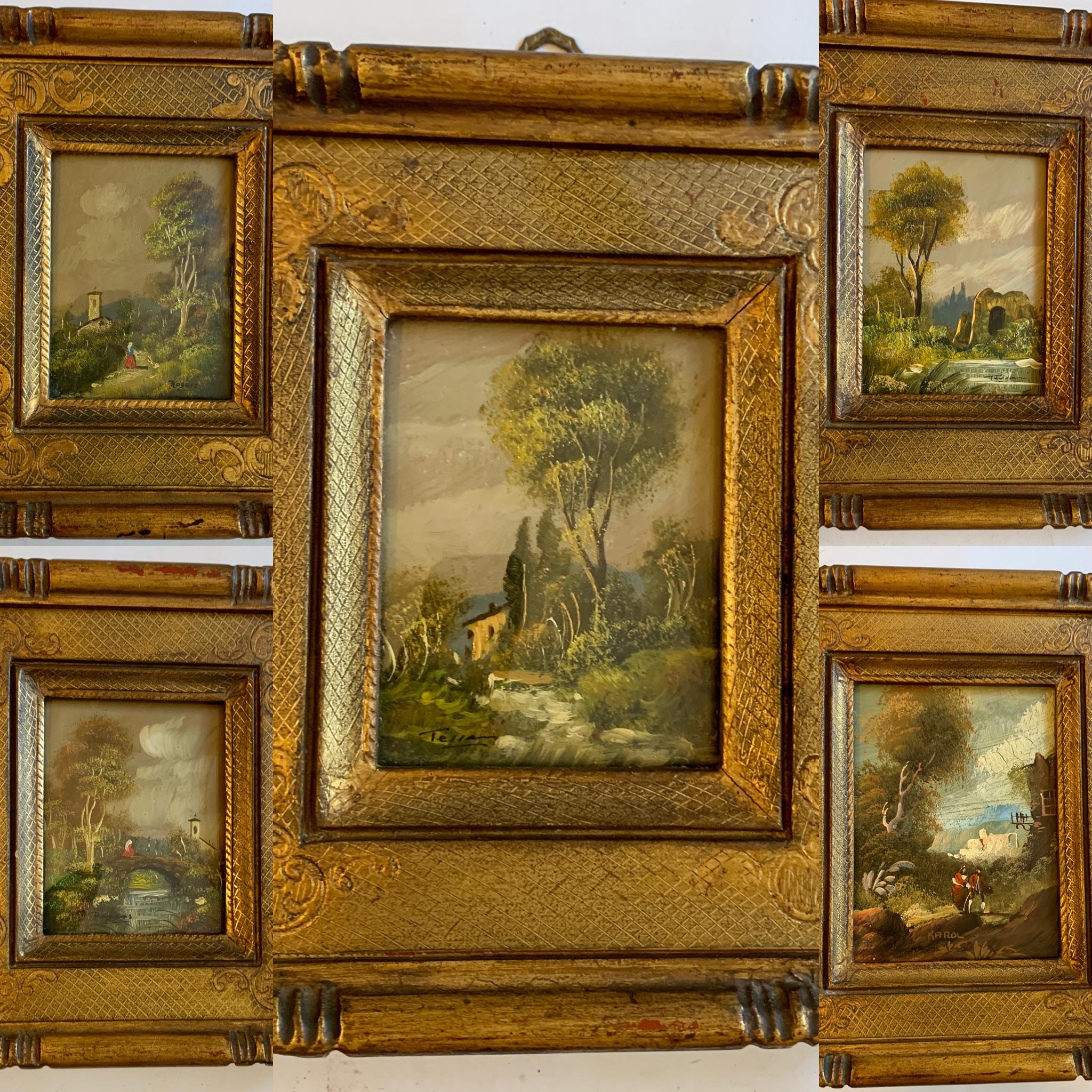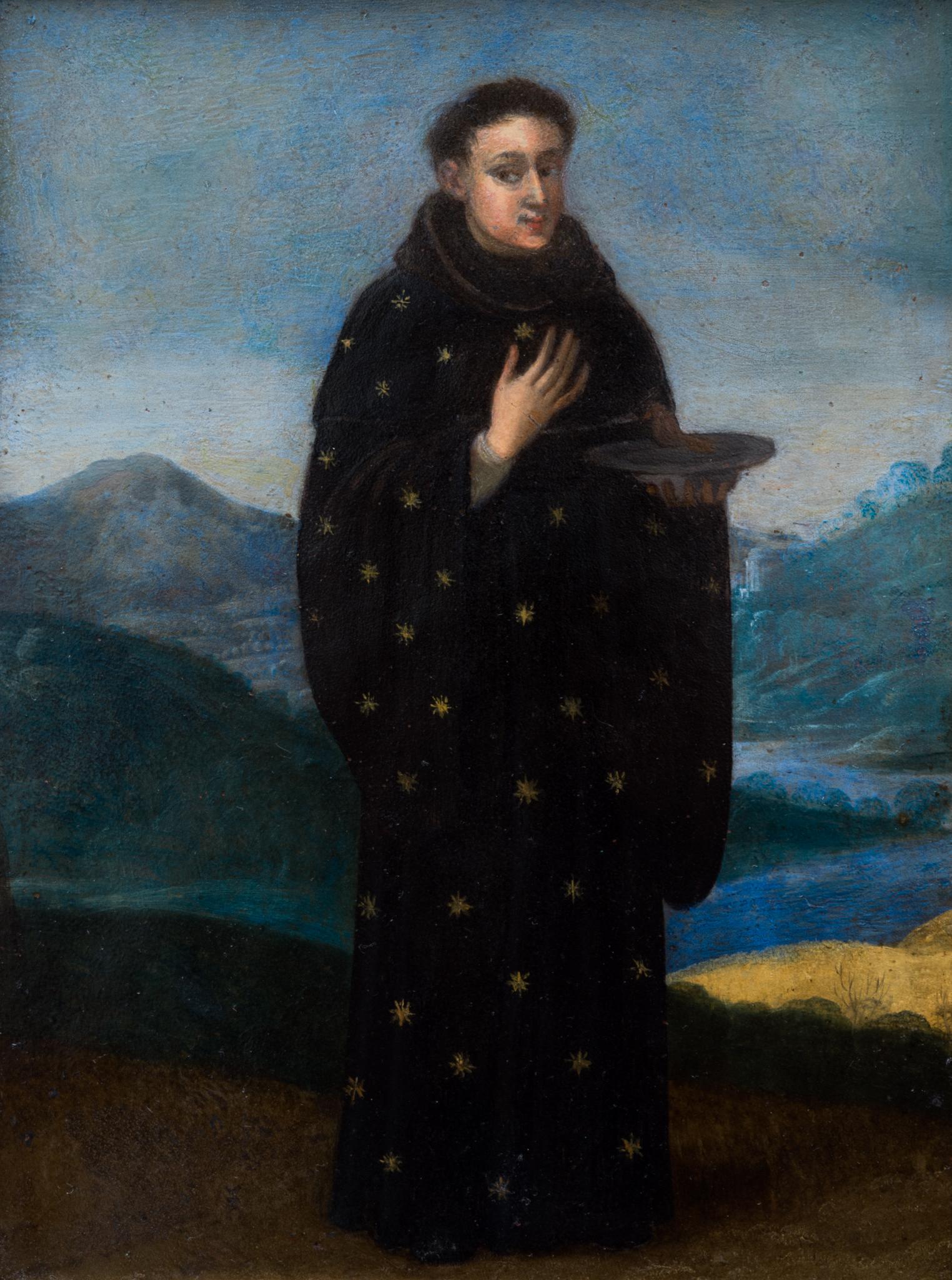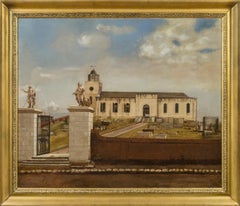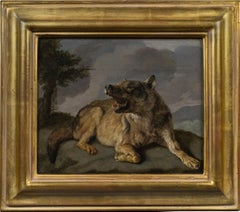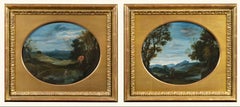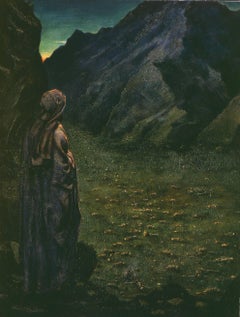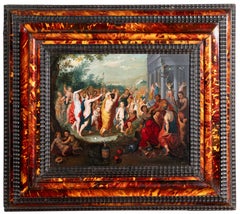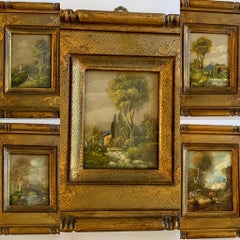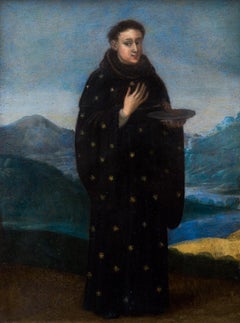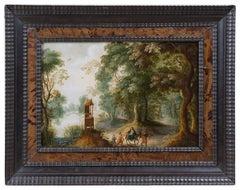Items Similar to Allegory of Abundance
Want more images or videos?
Request additional images or videos from the seller
1 of 4
Jan Brueghel the YoungerAllegory of Abundancec. 1630
c. 1630
About the Item
Painted in collaboration with Hendrick van Balen (Antwerp, 1575 – 1632).
Provenance: Private Collection, Uruguay, since the 1930s.
The eldest son of Jan Breughel the Elder, Jan the Younger trained with his father in Antwerp before setting off for Italy with his childhood friend Anthony van Dyck around 1620. He returned in 1625, becoming a member of the Antwerp painter’s guild (he would become Dean in 1630) and taking over his recently deceased father’s active and successful studio. While he remained active in his native city throughout his long career, his clients came from across Europe and included the Austrian and French courts. The subject matter of his paintings was varied, although he is best known for his idealized landscapes which might feature villages, as well as his allegories and mythological scenes, often made in collaboration with the specialists in figure painting, such as in the present example. Brueghel’s landscape—characterized by a meticulous handling of receding space and populated with beautifully-observed animals, fruits, flowers, and other natural elements—here serves as the setting for a meeting of gods and goddesses accompanied by a satyr, nymphs, and winged putti.
This work is a newly discovered and version of a composition treated on at least two other occasions by Brueghel. The best known is that in National Gallery in Prague with figures by Hendrick van Balen (Fig. 1), while another panel of similar dimensions with figures by Ambrosius Francken the Younger is in a private collection in New York (Fig. 2). Our painting is slightly larger than those two and is distinguished both by its copper support and more expansive treatment of the trees and sky across the top of the painting. As is typical of Jan Brueghel the Younger’s collaborative efforts, van Balen was responsible for the principal figures, while Brueghel painted the landscape, still-life elements, and staffage.
The subject of the work has been variously titled throughout the scholarly literature. For Gustav Glück it was an Allegory of Autumn; Klaus Ertz termed it an Allegory of Abundance; and Bettina Werche catalogued it as Bacchus, Venus, and Ceres. It may properly be considered all three. The harvest deities of Bacchus and Ceres flank the goddess of love Venus and well-illustrate the motto Sine Cerere et Baccho friget Venus (“Without Bacchus and Ceres, Venus grows cold”)—a quotation from the Roman dramatist Terence, suggesting that love disappears without the stimulus of wine and food. As Bacchus, the wine god, and Ceres, the goddess of agriculture, are associated with the bounty of the autumn harvest, their presence—in the context of the richness of the vegetation, produce, fruits, and flowers depicted—make the painting both an allegory of the season, and, more broadly, one of Abundance.
Brueghel was a master of creating a microcosm of the world—here encompassing both the earthly and the godly—in the limited space of a cabinet picture. The composition is created from two divergent diagonals that begin in the center foreground and receipt to the outer edges of the painting, pointing towards two distant landscape views punctuated by a pink and blue tinged sky. The mass of dense trees executed in earthy brown and green hues in the center of the middle-ground serves as a backdrop to the figures in the foregrounds and offsets the rich colors of their garments. These sophisticated compositional devises serve to create an attractive image that presents engaging passages of visual interest throughout.
Dr. Klaus Ertz has confirmed Jan Brueghel the Younger authorship of the painting, with figures by Hendrick van Balen, upon firsthand inspection (certificate of 7 April 2022). Ertz dates the work ca. 1630, shortly after Breughel’s return from Italy in 1625.
- Creator:Jan Brueghel the Younger (1601 - 1678, Flemish)
- Creation Year:c. 1630
- Dimensions:Height: 29.88 in (75.9 cm)Width: 41.25 in (104.78 cm)
- Medium:
- Movement & Style:
- Period:
- Condition:
- Gallery Location:New York, NY
- Reference Number:1stDibs: LU10210793482
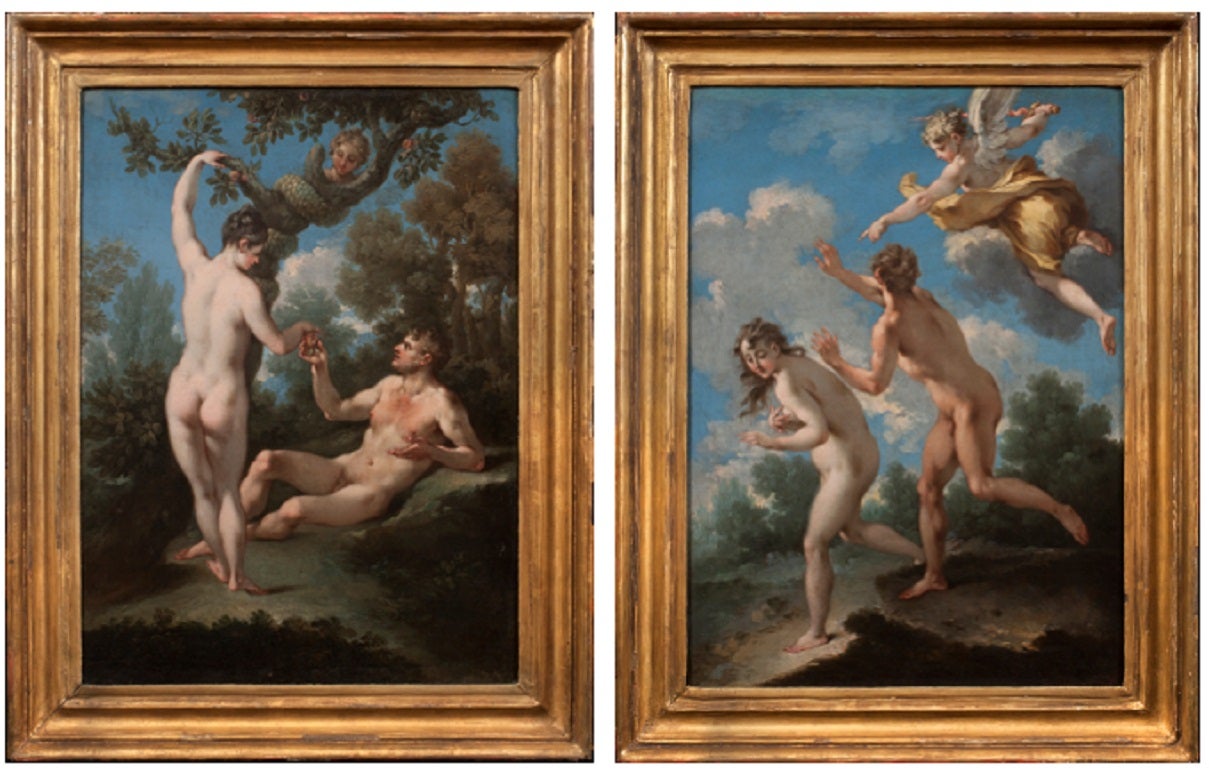
About the Seller
5.0
Recognized Seller
These prestigious sellers are industry leaders and represent the highest echelon for item quality and design.
Established in 1997
1stDibs seller since 2012
19 sales on 1stDibs
Typical response time: 12 hours
- ShippingRetrieving quote...Shipping from: New York, NY
- Return Policy
Authenticity Guarantee
In the unlikely event there’s an issue with an item’s authenticity, contact us within 1 year for a full refund. DetailsMoney-Back Guarantee
If your item is not as described, is damaged in transit, or does not arrive, contact us within 7 days for a full refund. Details24-Hour Cancellation
You have a 24-hour grace period in which to reconsider your purchase, with no questions asked.Vetted Professional Sellers
Our world-class sellers must adhere to strict standards for service and quality, maintaining the integrity of our listings.Price-Match Guarantee
If you find that a seller listed the same item for a lower price elsewhere, we’ll match it.Trusted Global Delivery
Our best-in-class carrier network provides specialized shipping options worldwide, including custom delivery.More From This Seller
View AllView of St. John’s Cathedral, Antigua
Located in New York, NY
Provenance:
Robert Hollberton, Antigua, ca. 1841
Private Collection, New York
The present painting depicts Old St. John’s Cathedral on the island of Antigua. The church was erected in the 1720s on the designs of the architect Robert Cullen. It measured 130 feet by 50 feet with north and south porches 23 x 20 ½ feet. The tower, 50 feet high with its cupola, was added in 1789. The church was elevated to the status of a cathedral, but disaster struck in the form of an earthquake that destroyed the building on 8 February 1843. A memorandum of that date relates the event:
“On Wednesday, 8th February, 1843, this island was visited by a most terrific and destructive earthquake. At twenty minutes before eleven o’clock in the forenoon, while the bell was ringing for prayers, and the venerable Robert Holberton was in the vestry-room, awaiting the arrival of persons to have their marriage solemnized, before the commencement of the morning service, the whole edifice, from one end to the other, was suddenly and violently agitated. Every one within the church, after the first shock, was compelled to escape for his life. The tower was rent from the top to the bottom; the north dial of the clock precipitated to the ground with a dreadful crash; the east parapet wall of the tower thrown upon the roof of the church; almost the whole of the north-west wall by the north gallery fell out in a mass; the north-east wall was protruded beyond the perpendicular; the altar-piece, the public monument erected to the memory of lord Lavington, and the private monuments, hearing the names of Kelsick, Warner, Otley, and Atkinson, fell down piecemeal inside; a large portion of the top of the east wall fell, and the whole of the south-east wall was precipitated into the churchyard, carrying along with it two of the cast-iron windows, while the other six remained projecting from the walls in which they had been originally inserted; a large pile of heavy cut stones and masses of brick fell down at the south and at the north doors; seven of the large frontpipes of the organ were thrown out by the violence of the shock, and many of the metal and wooden pipes within displaced; the massive basin of the font was tossed from the pedestal on which it rested, and pitched upon the pavement beneath uninjured. Thus, within the space of three minutes, this church was reduced to a pile of crumbling ruins; the walls that were left standing being rent in every part, the main roof only remaining sound, being supported by the hard wood pillars.”
The entrance from the southern side into the cathedral, which was erected in 1789, included two imposing statues, one of Saint John the Divine and the other of Saint John the Baptist in flowing robes. It is said that these statues were confiscated by the British Navy from the French ship HMS Temple in Martinique waters in 1756 during the Seven Years’ War and moved to the church. The statues are still in situ and can be seen today, much as they appeared in Bisbee’s painting, but with the new cathedral in the background (Fig. 1).
Little is known of the career of Ezra Bisbee. He was born in Sag Harbor, New York in 1808 and appears to have had a career as a political cartoonist and a printmaker. His handsome Portrait of President Andrew Jackson is dated 1833, and several political lithographs...
Category
19th Century Old Masters Landscape Paintings
Materials
Oil, Canvas
A Wolf
Located in New York, NY
Provenance:
The Marchesi Strozzi, Palazzo Strozzi, Florence
Sale, Christie’s, London, May 20, 1993, lot 315, as by Carl Borromaus Andreas Ruthart...
Category
17th Century Old Masters Animal Paintings
Materials
Paper, Canvas, Oil
Two Scenes of Diana and Actaeon (a pair)
By Giovanni Battista Viola
Located in New York, NY
Provenance:
Robert L. and Bertina Suida Manning, New York, until 1996
Private Collection, USA
Giovanni Battista Viola was born in Bologna a...
Category
17th Century Baroque Landscape Paintings
Materials
Copper
Ezekiel in the Valley of Dry Bones
By Philip Burne-Jones
Located in New York, NY
Provenance:
Christie’s, London, 3 March 1922, lot 46 (with The Tower of Babel);
James Nicoll
Private Collection
Sotheby’s, London, 29 March 1983, lot 157
Private Collection, New Yo...
Category
Late 19th Century Victorian Figurative Paintings
Materials
Canvas, Oil
Allegory of Fortune
Located in New York, NY
Provenance:
S. Spinelli Collection, Florence; their sale, Galleria Pesaro, Milan, July 11-14, 1928, lot 112 (unsold); reoffered Galleria Luigi Bellini, Florence, April 23-26, 1934, lot 132, as manner of Baldassare Peruzzi
Dr. Giacomo Ancona, Florence, 1930s, and after 1939, San Francisco; thence by descent to his son:
Mario Ancona, San Francisco; thence by descent to his children:
Mario Ancona III and Victoria Ancona, San Francisco, until 1995; thence to:
Phyllis Ancona Green, widow of Mario Ancona, Los Angeles (1995-2012)
Literature:
Donato Sanminiatelli, Domenico Beccafumi. Milan 1967, p. 170 (under paintings attributed to Beccafumi)
Among the precious survivors of Renaissance secular paintings for domestic interiors are several unusual and particularly attractive panels painted in Siena at the end of the fifteenth and beginning of the sixteenth centuries. These paintings depict exemplary figures from antiquity—heroes or heroines, as well as allegorical, literary, and mythological figures. For the most part, these panels have survived in groups of three, although it is possible that some of these works were painted either as part of larger series or as individual projects. One such trio by Beccafumi consists of two paintings now at the National Gallery, London (Marcia and Tanaquil) and a third in the Galleria Doria-Pamphilj, Rome (Cornelia). These were commissioned around 1517–1519 for the bedroom of Francesco di Camillo Petrucci in Siena and were most likely placed together as elements in the wall decoration (spalliere) or installed above the back of a bench or cassapanca. Another, earlier (ca. 1495–1500), set of three—Guidoccio Cozzarelli’s Hippo, Camilla, and Lucretia (Private Collection, Siena) survives with its original wooden framework—a kind of secular triptych. Judith, Sophonisba, and Cleopatra in the collection of the Monte dei Paschi, Siena, are by an anonymous artist close to Beccafumi called the “Master of the Chigi-Saracini Heroines.” Girolamo di Benvenuto’s Cleopatra, Tuccia, and Portia are dispersed (homeless, Prague, Chambery), and Brescianino’s Faith, Hope, and Charity are in the Pinacoteca Nazionale in Siena.
The present painting first appeared in the Spinelli sale in Florence in 1934, at which time it was sold with two panels of identical size and format. Each was catalogued as being by the “manner of Baldassare Peruzzi” and of unidentified subject. Of these, the painting depicting a male figure turned to the right has recently reappeared in a private Italian collection, while the location of the third work, portraying a cloaked figure turned three-quarters left, remains unknown. Our panel depicts the allegorical figure of Fortune. Here she is represented in typical fashion as a nude female figure balanced on a wheel (sometimes called the Rota Fortunae), her billowing drapery indicating that she is as changeable as the wind. The appearance of the Virgin and Child in the cloud at the upper right is an unusual addition to the iconography. The subjects of the two pendant male...
Category
16th Century Old Masters Paintings
Materials
Oil, Panel
Rebecca at the Well
Located in New York, NY
Provenance:
Dr. James Henry Lancashire, Manchester-by-the-Sea, Massachusetts, by 1925; probably by descent to:
Private Collection, Cumberland Foreside, Maine, until 2018
This unpublished panel is a characteristic work of the Master of the Apollo and Daphne Legend, an anonymous Florentine painter in the circle of Bartolommeo di Giovanni, Domenico Ghirlandaio, and Sandro Botticelli. The artistic personality of the Master of the Apollo and Daphne Legend was independently recognized by Everett Fahy and Federico Zeri at roughly the same moment in time. Fahy originally dubbed this artist the Master of the Ryerson Panels but later adopted Zeri’s name for the artist, which derives from his eponymous works from the Samuel H. Kress collection (Figs. 1-2). Fahy posited that the artist was most likely a pupil of Ghirlandaio active from roughly 1480 to 1510, and that he may be identifiable with one of Ghirlandaio’s documented pupils to whom no works have been securely attributed, such as Niccolò Cieco, Jacopo dell’Indaco, or Baldino Baldinetti. The present painting was first attributed to this master by Everett Fahy in 1989, who became aware of its existence only after publishing his definitive studies on the artist.
The surviving body of work by the Master of the Apollo and Daphne Legend is largely composed of series of panels treating the same theme. In addition to the works illustrating the legend of Apollo and Daphne, there are also series on the themes of Susanna and the Elders and the story of Saint Joseph, among others. The subject of the present panel is drawn from Genesis 24, the story of Isaac. It is possible that our painting relates to another work by the artist depicting the Sacrifice of Isaac formerly in the collection of E. A. McGuire in Dublin, Ireland (Fig. 3), and that these two panels were originally part of a decorative scheme based on the story of Isaac.
Although the Master’s paintings of this type have traditionally been considered painted fronts of wedding chests, known as cassoni, the scale of these paintings and the fact that they are often part of a series indicates that they are more likely spalliera panels—paintings set into furniture or the wainscoting of a room. The biblical episode depicted in this painting centers on the theme of marriage, which suggests that this work was likely commissioned for the domestic interior of a newly married couple. The Master has transcribed into paint even the minute details of this Old Testament story, in which Abraham sends a servant to travel by camel to the land of his father and seek out a wife for his son Isaac. The servant is here shown at the well...
Category
15th Century and Earlier Old Masters Figurative Paintings
Materials
Tempera, Oil, Wood Panel
You May Also Like
The Triumph of the Infant Bacchus, workshop of H. Van Balen, 16th c. Antwerp
By Hendrick van Balen
Located in PARIS, FR
The Triumph of the Infant Bacchus,
Workshop of Hendrick Van Balen (1575-1632)
Antwerp, c.1630
Oil on copper, h. 28 cm (11.02 in), w. 35 cm (13.78 in)
A large Roman 17th century golden painted frame
Framed: h. 52 cm (20.47 in.), w. 58 cm (22.83 in)
Our finely painted work depicts The Triumph of the Bacchus as a young boy and is one of the most popular mythological subjects in Antwerp at the beginning of the 17th century. Feasting, wine and fun are the themes that constantly appeal to the public.
Thus unfolds before our eyes on our painting the procession composed of nymphs, baccantes, fauns, satyrs and children, their bodies naked, partially covered with brightly coloured draperies that help to brighten up the parade. Playing various instruments, dancing and drinking, while carrying vases and poles adorned with grapevines, participants to the rhythm of a noisy brass band make their way to an ancient temple standing on the right. The exaggerated gestures convey to us the frenzy of the excited crowd.
The Child Bacchus follows the joyous procession, carried by satyrs and nymphs, crowned with ivy and joyfully raising a cup of wine. In the foreground, the drunken participants leave the procession, the children on the left and the group of bacchantes and satyrs on the right are resting among various objects scattered at their feet: cups, vases, ewers bear witness to the festivities in progress.
In the background, a hilly landscape stretches out on the horizon, a semblance of calm that contrasts with the bustle of the foreground.
The artist strives to multiply the many details, whether it be figures, costumes, flowers or vegetation, in order to demonstrate his know-how and the perfection of his execution.
The acidulous palette with fresh and varied colours is characteristic of Hendrick Van Balen's works.
There are several versions identical to ours with similar dimensions painted by Hendrick Van Balen and his workshop.
Related works:
• Koller Auction, Zurich, 21/09/2007, oil on copper, 28,5 x 37,4 cm.
• Staatliche Kunsthalle, Karlsruhe, Inv. N° 809 (oil on copper, 40 x 53,5 cm)
• Auktionshaus für Altertümer Glückselig, Vienne, 10/05/1932, ( oil on copper, 34 x 42 cm)
• Gemäldegalerie of Pommersfelden, Schloss Weissenstein, oil on panel, 47 x 64 cm
Hendrick Van Balen, Flemish painter, born and died in Antwerp (1575-1632). A pupil of Adam Van Noort, he entered the Guild of St. Luke in 1593, later trained in Italy and was Van Dyck's first teacher. He often painted small figures taken from scenes from the Bible or classical mythology, on paintings whose backgrounds and landscapes were painted by Josse de Momper...
Category
17th Century Old Masters Figurative Paintings
Materials
Copper
Five mid 20th century Italian oil landscapes with figures, castles, Churchs
Located in Woodbury, CT
A very interesting set of five mid-20th-century Italian oils on copper.
All five are classical landscape subjects and are signed Roger, though we don't know which artist with the n...
Category
1950s Old Masters Landscape Paintings
Materials
Copper
$5,560 Sale Price
20% Off
Free Shipping
Old Master Painting, Flemish School from 1600s, Saint Nicholas of Tolentino
Located in Stockholm, SE
This small Flemish painting, measuring only 24.5 x 18.5 cm and executed on a copper plate, depicts Saint Nicholas of Tolentino. Created in the 17th century, the artist remains unknow...
Category
17th Century Old Masters Landscape Paintings
Materials
Copper
$3,926 Sale Price
25% Off
17th c. Flemish - Landscape with Flight to Egypt - Antwerp circa 1630
Located in PARIS, FR
LANDSCAPE WITH FLIGHT TO EGYPT,
JASPER VAN DER LANEN (ANTWERP, 1585 - 1634)
17TH CENTURY FLEMISH SCHOOL
ANTWERP CIRCA 1630
Oil on copper, dimensions: h. 10.23 in, w. 14.96 in
Flemish style frame in ebonized wood adorned with wavy moldings and wood veneer.
Framed dimensions: h. 17.32 in, w. 21.65 in
Provenance:
Philips auction...
Category
Early 17th Century Old Masters Figurative Paintings
Materials
Copper
$9,365 Sale Price
30% Off
Abraham and the Sacrifice of His Son Isaac by Adriaen Van Stalbemt, C. 1605-1610
Located in Stockholm, SE
Artist: Adriaen van Stalbemt (Stalbempt) 1580-1662
Title: Abraham and the Sacrifice of His Son Isaac “Das Opfer des Abraham”
According to the Old...
Category
Early 1600s Old Masters Landscape Paintings
Materials
Copper
Allegory of Summer, workshop of Hendrick Van Balen 17th c. Antwerp school
By Hendrick van Balen
Located in PARIS, FR
Allegory of summer, personified by Ceres
Workshop of Hendrick Van Balen
Antwerp School, early 17th century.
Oil on copper,
Dimensions: h. 52 cm, l. 40cm
Antic giltwood frame
Framed dimensions: h. 74 cm, l. 60cm
Very good condition
Our delicately painted work is part of the pictorial tradition that is both allegorical and mythological in vogue in Antwerp, whose leaders are Jan Brueghel the Younger and Hendrick Van Balen. Numerous works emerging from their workshops illustrate mythological subjects, the seasons, the elements, the senses or intertwining the lush landscapes, animals and gods of Olympus.
At the heart of a green landscape dominated in its center by a generous apple tree, the beautiful Ceres, partially dressed in a large blue drape, is wearing a crown of ears of wheat, her symbol of the goddess of the earth and harvests. She holds the sickle in her right hand and carries sheaves of wheat. To her right a nymph holds the cornucopia while puttis pick and offer flowers.
In the foreground are the summer fruits: figs, cherries, apples and lemons. A squirrel munching on cherries symbolizes toil and foresight, themes that are echoed in the work of the harvesters on the wheat fields in the background.
The background is composed of vegetation, on the right a wild rose bush with its branches erect against a tree trunk, in the center of the trees with silvery green foliage.
Our painter, a student of Hendrick Van Balen, finds his inspiration in the works of the master such as this nymph in yellow drapery seen from behind, one of the figures which accompanies many of the master's paintings. The elegant gestures, the flesh...The indisputable influence of Jan Brueghel the Younger is revealed in the treatment of trees and flowers, wild roses, tulips as well as in the still life with the squirrel in the foreground.
The craze for this type of virtuoso painting where the mythological figures are only a pretext to better illustrate the landscape and plant species surrounding them, then generated orders from all over Europe.
Hendrick Van Balen, Flemish painter, born and died in Antwerp (1575-1632). A student of Adam Van Noort, he entered the guild of Saint-Luc in 1593, later trained in Italy and was Van Dyck's first master. He often painted small characters taken from scenes from the Bible or classical mythology, on paintings in which Josse de Momper...
Category
Early 17th Century Old Masters Figurative Paintings
Materials
Copper
Recently Viewed
View AllMore Ways To Browse
Fig Still Life Painting
7 Gods
17th C Still Life Painting
Black Wine Cabinet
Antique Food Cabinet
Autumn Meeting
Still Life Flowers Wine
17th Century French Still Life Oil Paintings
Satyr Painting
Fig Still Life
The Satyr Paintings
Antique Copper Picture Frames
Satyr And Nymph
Bacchus Paintings
Oil Painting Anthony Van Dyck
Studio Of Anthony Van Dyck
Van Balen
Paris Landscape Oil On Canvas

